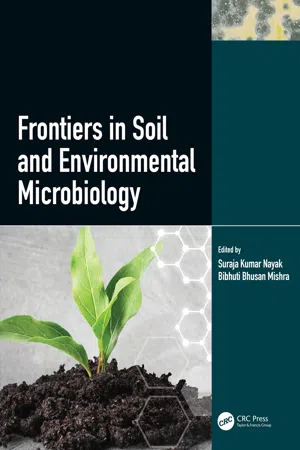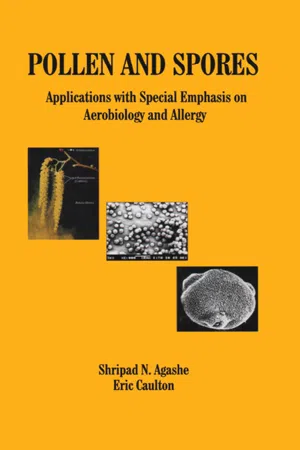Biological Sciences
Aspergillus
Aspergillus is a genus of mold fungi commonly found in the environment, including soil, decaying vegetation, and indoor environments. Some species of Aspergillus can cause respiratory infections in humans, particularly in individuals with weakened immune systems. Additionally, certain species of Aspergillus are used in the production of various industrial enzymes and organic acids.
Written by Perlego with AI-assistance
Related key terms
4 Key excerpts on "Aspergillus"
- eBook - ePub
- Suraja Kumar Nayak, Bibhuti Bhusan Mishra(Authors)
- 2020(Publication Date)
- CRC Press(Publisher)
The genus Aspergillus encompasses organisms with characteristics of high pathological, agricultural, industrial, pharmaceutical, scientific and cultural importance (Dawood and Mohamed 2015). Species richness of the genus Aspergillus and the ability to produce a large number of extrolites, secondary metabolites, bioactive peptides, proteins, lectins, enzymes, hydrophobins and aegerolysins have projected them as potential microbial agents for an array of beneficial activities (Frisvad and Larsen 2015). Similar to many other fungal groups, non-pathogenic strains like Aspergillus niger, A. terreus, A. nidulans, etc. have become potentially indispensable tools for multifarious jobs in agricultural soil and environment. The vital role played by many Aspergillus fungi in the cycling of major nutrients like carbon, nitrogen, phosphorus, sulphur, etc. has been exploited and a number of species have been evaluated and identified to be utilized as potential biofertilizers. The types of fungal organisms involved in this process carry out solubilization and mobilization of insoluble compounds and also mineralize organic forms of elements into organic forms in the soil to make the nutrients available for plant use (Chakraborty et al. 2010; Casida 1959; Bhattacharya et al. 2015; Gupta et al. 2007). Secondary metabolites of the same fungi also exerted an antibiosis effect on other pathogenic fungi which caused devastating diseases in plants (Zafar et al. 2015; Daami-Remadi et al. 2006; Kaewchai and Soytong 2010; Mansfield et al. 2012). Many non-toxigenic strains of A. flavus could be successfully applied in the field for competitive elimination of aflatoxigenic strains. Furthermore, some common and uncommon species of this group of fungi also produce important plant growth hormones like auxins, gibberellins, cytokinins, indole-3acetic acid (IAA), etc - eBook - ePub
- Mahmoud Ghannoum, Matthew Parsek, Marvin Whiteley, Pranab K. Mukherjee(Authors)
- 2015(Publication Date)
- ASM Press(Publisher)
8Aspergillus Biofilm In Vitro and In VivoANNE BEAUVAIS1 and JEAN-PAUL LATGÉ1INTRODUCTION
Aspergillus fumigatus is the most important airborne fungal pathogen in the world. The conidia are inhaled by the entire population and cause a wide range of diseases from simple rhinitis to fatal invasive aspergillosis (IA) in immunocompromised patients (1 ). The number of A. fumigatus chronic infections is constantly increasing in immunocompetent patients suffering from respiratory problems such as chronic obstructive pulmonary disease (22%), asthma (1 to 5%), and cystic fibrosis (5 to 10%), along with 15% allergic bronchopulmonary aspergillosis. Aspergillus is also the cause of lung and sinus aspergilloma and serious fungal keratitis infections (2 , 3 ).Until a few years ago, most studies undertaken to understand Aspergillus physiology and virulence were performed with the fungus growing in shaken liquid flasks or fermentors. Such an experimental set-up was the most appropriate to obtain an important biomass to undertake biochemical studies and to purify secreted molecules or antigens from the culture filtrates or mycelial extracts. In contrast, in all Aspergillus infections, as well as in nature on a solid substratum, A. fumigatus grows as a colony characterized by multicellular and multilayered hyphae which are embedded in an extracellular matrix (ECM) (4 , 5 ). This type of growth is consistent in general with the definition of a biofilm: a structural microbial community of cells enclosed in an ECM. However, A. fumigatus biofilms are very different from yeast biofilms (6 ). In this regard, biofilms formed by filamentous fungi contain septate hyphae that are structurally attached to form microbial colonies. Thus, a better understanding of the infectious process should be based on the study of the biofilm colonies rather than on cells grown in planktonic form in shaken flasks. This article will summarize our present knowledge of biofilms formed by A. fumigatus and the role of ECM components during biofilm growth in vivo and in vitro . In addition, we will discuss the molecular resistance of A. fumigatus - eBook - ePub
- Rolf A. Prade, Hans J. Bohnert(Authors)
- 2003(Publication Date)
- CRC Press(Publisher)
1Aspergillus
Michael J. Anderson and Jayne L. BrookmanUniversity of Manchester, Manchester, EnglandDavid W. DenningUniversity of Manchester and Wythenshawe Hospital, Manchester, EnglandI. INTRODUCTION
Aspergillosis, the name given to all diseases caused in animals by fungi in the genus Aspergillus, includes allergic, superficial, saprophytic, and invasive disease. More than 180 species of Aspergillus are recognized (1 ), but only a few cause disease with any regularity: A. fumigatus, A. flavus, A. terreus, and A. niger group species. Aspergilli are common saprophytes in the environment, especially in composting facilities. The pathogenic Aspergilli are found the world over, but soil isolation rates do increase towards the equator. Most aerobiology studies have been done in Europe and some have shown a seasonal variation in airborne Aspergillus counts. Aspergillus species comprise from 1% to 6% of the total air flora outside and, if speciated, A. fumigatus comprises from 4% to 41% of the Aspergillus total (2 ). The usual concentration of Aspergillus conidia in outside air is 1 to 30 conidia/m3 , but can rise to as high as 7 × 107 /m3 inside a barn, after hay or straw disturbance. In hospitals, conidia concentrations in air also vary typically from 0 to 1 × 102 /m3 with much variation in the same site (3 –5 ). Inside human dwellings, Aspergillus species may be found in high concentrations in potted plants (50 conidia/g soil) (6 ), damp cellars, dusty crawl spaces, and condiments, especially pepper (106 conidia/g) (2 ) and ground spices.Human disease has been increasing over the 5 decades since invasive aspergillosis was first described in the immunocompromised patient (7 ). Invasive aspergillosis (IA) is the most common life-threatening invasive mold infection worldwide. It usually complicates treatments and diseases associated with immunosuppression, including allogeneic bone marrow transplantation, lung and liver transplantation, the treatment of acute leukemia, late-stage acquired immunodeficiency syndrome (AIDS) and a variety of other diseases treated with corticosteroids (8 ). Invasive aspergillosis rarely affects nonimmunocompromised patients. The incidence of invasive aspergillosis was calculated to have risen 14-fold in the 15-year period up to the end of 1992, as seen in autopsy data from one major teaching hospital in Frankfurt, Germany, with 5% of autopsied patients having invasive aspergillosis in the last year of this survey (9 ). In a national autopsy survey in Japan from 1969 to 1994, invasive aspergillosis increased from 0.4% to 1.3% in all autopsies (10 ). Another autopsy series in a European teaching hospital demonstrated a 4% rate of invasive aspergillosis in unselected autopsies (11 ). A culture-based population study in the San Francisco area (requiring cases to have, for example, two culture-positive bronchoscopy specimens or a sterile site positive by culture, which probably underrepresents invasive aspergillosis by perhaps 90%) showed increasing rates of disease over the last 25 years (12 - eBook - ePub
Pollen and Spores
Applications with Special Emphasis on Aerobiology and Allergy
- S N Agashe(Author)
- 2019(Publication Date)
- CRC Press(Publisher)
CHAPTER16
Significance of Fungi as Aeroallergens
HISTORICAL ACCOUNT: HISTORY OF ALLERGIC DISEASES CAUSED BY FUNGAL AEROALLERGENS
The possibility of fungal allergy was first mentioned by Cadham (1924) and Van Leeuwen (1924). However, the first systematic studies of fungal allergy were those of Feinberg (1935). The first systematic aerobiological work including airborne fungi in India was carried out by Cunningham (1873) in Calcutta. Agnihotri (1980) studied the fungi in the bedroom of bronchial asthma patients and found Aspergillus niger, Aspergillus flavus, Aspergillus versicolor, Aspergillus fumigatus and Helminthosporium sp. as dominant fungi. The percentage of fungal spores in the air is approximately 10 times higher than that of pollen grains, however by volume the pollen dominate.Ravindran (1991) investigated the aeromycoflora of Kerala and reported the dominance of Aspergillus, Penicillium, Cladosporium and Alternaria. Agashe et al. (1983) studied the aeromycoflora of Bangalore and found Cladosporium sp. and Alternaria sp. to be predominant. Agashe and Anuradha (1996) isolated the dominant fungal types Cladosporium, Penicillium, Aspergillus, Trichoderma and Fusarium from the hospital ward exposures of Petri dishes.Hyde (1972) had suggested that a fungal spore to be qualified as a potential aeroallergen has to satisfy following features:1. The spore must be produced in large quantities. 2. The spore must be sufficiently buoyant to become airborne. 3. The spore-producing species must be widely and abundantly distributed. 4. The spore should contain an excitant of hay fever or asthma. 5. Symptoms must occur when the spores are numerous in the air.Regional spore calendars are based on seasonal variation and circadian periodicity. This has proved significantly useful for the clinicians in proper treatment of innumerable ailing patients of allergy. There is an absolute need of trained aerobiologists and clinicians working in close cooperation and also need of an extensive network of allergy clinics in the Indian subcontinent.
Learn about this page
Index pages curate the most relevant extracts from our library of academic textbooks. They’ve been created using an in-house natural language model (NLM), each adding context and meaning to key research topics.



